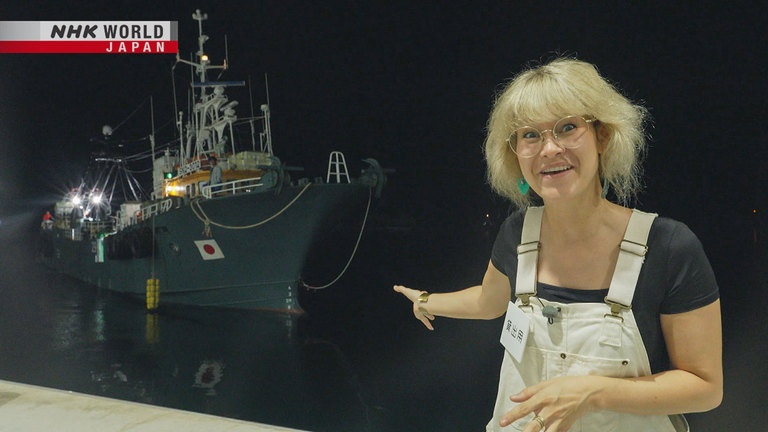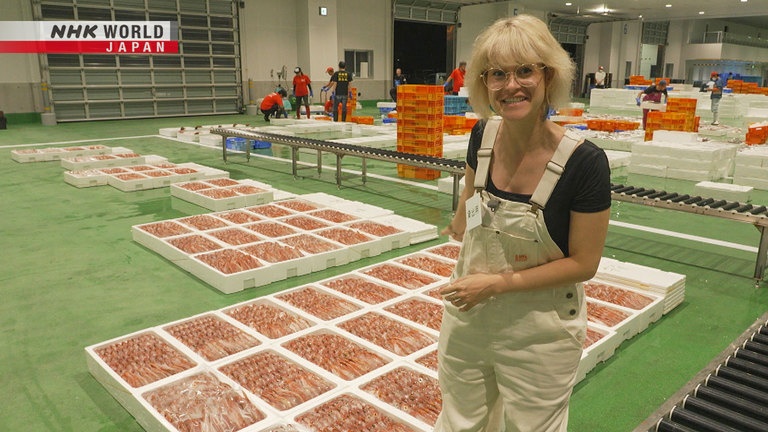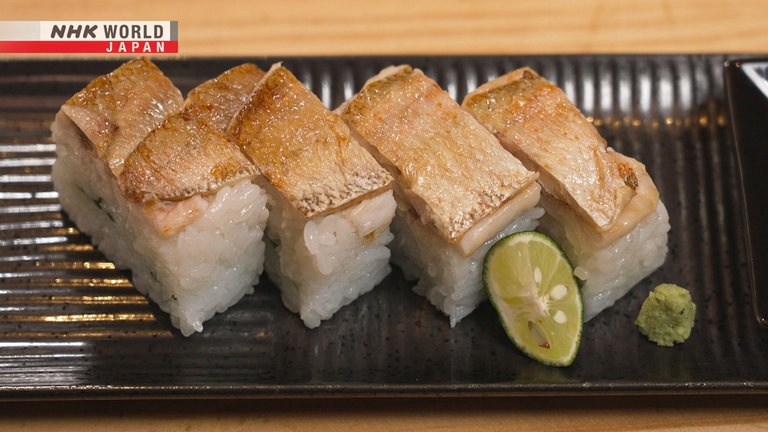NODOGURO
Nodoguro, characterized by red scales and large eyes, is a fatty, umami-packed fish. Starting out on regional dinner tables, it achieved national fame along with the development of the internet and shipping technology. Its flavor had a lot to do with its success, as demand eventually bumped nodoguro up to high-end prices! Visit Hamada Fishing Port in Shimane Prefecture to learn nodoguro's importance on local industry, and feast your eyes on juicy dishes at Japanese and French restaurants in Tokyo. (Reporter: Saskia Thoelen)




Transcript
Tokyo: this world-class metropolis is a veritable gourmet wonderland.
Discover the stories behind the ingredients that make this city so delicious - so "oishii."
"Nodoguro," or blackthroat seaperch, are the red jewels of the deep sea.
The high-end fish are characterized by their vivid color and big round eyes.
With umami-packed, fatty meat, they're nicknamed "the white fatty toro," or the fatty tuna of white fish.
It's sweet.
Right, from the fat content.
It's really good.
Nodoguro reached high-end status in the 2000s.
Before that, they were moderately priced and mainly consumed in production regions.
As an island nation, Japan has all kinds of seafood.
Dive in to find out why nodoguro in particular are so highly sought after.
Trails to Oishii Tokyo.
Hi, this is Saskia from Belgium.
In Japan, many different types of fish are eaten as the country is surrounded by sea.
Among these, tuna or "fugu" are considered as high-class fish.
However, there's another type of fish that is considered extra high-class, and that is nodoguro.
What kind of fish is it?
And how does it taste like?
Let's go find out.
The Tsukiji Outer Market is home to some 400 food-related shops.
It's also a popular spot for tourists.
So many different types of fish.
They seem to have a lot of special ones here.
Hello.
I'm here for nodoguro.
- Huh? Nodoguro?
- For nodoguro.
- Do you have any?
- Yeah, right here.
I see.
Wow, lovely color.
Cute. Big eyes!
Right, they're deep-sea fish.
That's why they have big eyes?
Yeah, so they can find food in the dark.
Makes sense.
The shop sells mainly high-end fish.
Moriya Takashi, an experienced connoisseur, buys fish at the wholesale market every morning.
It doesn't say nodoguro.
Nodoguro is its common name.
It's officially called "akamutsu."
Why do people call it nodoguro?
It has a black throat.
"Nodo" means throat.
And "guro" is black.
Hence the nickname nodoguro!
It's similar to its English name!
Here's some rare deep-sea footage of the fish.
They live in the western Pacific Ocean at depths of 1-200 meters.
Little is known of their ecology, making aquiculture difficult.
All those sold on the market are caught in the wild.
The black throat is said to be a product of evolution.
It's so their prey can't see a big open mouth coming at them in the deep, dark waters.
What do they eat?
Bottom feeders like shrimp and crabs.
They eat nice food.
I hear nodoguro are expensive.
Very high-end.
Seriously.
So, how much?
This one is around 50 dollars.
That much?
For one?
At around 25 centimeters long, they can cost 50 dollars or more!
Moriya says big ones are especially fatty.
Good ones are fatty with rich umami.
That naturally makes them pricey.
Have they always been expensive?
Not exactly.
International customers, particularly from China,
started eating them and participating in auctions.
That pushed prices up more.
- They got famous.
- Right.
With the spread of the internet and advances in shipping technology,
more people came to know about tasty nodoguro.
Prices went up quickly, and the fish became a high-end luxury.
Saskia heads to the nearby Ginza area to visit a restaurant that specializes in nodoguro cuisine.
Hello, I'm Saskia.
Thanks for having me.
I'm the manager, Watanabe.
Thanks for coming.
He gets to work on an assortment of sashimi.
Fatty juices flow out of the tender white meat.
These pieces are thinly sliced.
This is "aburi" - thick slices with seared skin.
The sashimi is arranged to show the whole fish.
Wow. This is a lot.
Yes. We offer nodoguro
that weight over 500 grams.
It's dubbed "the white toro," or white fatty tuna.
It has great fat content that makes it sweet.
She'll try a thinner slice first.
- It has a mild flavor. Very nice.
- Right.
You said fatty, so I thought it'd be richer.
Its fat isn't too oily or heavy.
It's light and refreshing.
It melts in my mouth.
So good. "Oishii!"
Now for some "aburi."
It's been lightly salted - just add a bit of wasabi.
"Itadakimasu."
This one is different.
Umami is packed between the skin and meat,
so seared is the best way to enjoy its flavor.
I agree.
So they say that this is almost similar as the tuna, the toro of the tuna, but then for a white fish.
And you really sense that.
There's like the nice oily flavor that comes in together with the umami of the fish.
It's really brought right out by the salty flavor.
It's so good and melts in the mouth.
Oh, it's delicious.
Next up, grilled nodoguro.
Salted fish is cooked over a distant flame, keeping it nice and plump.
- I like grilled fish.
- Tasty?
The fat content keeps it tender and moist.
Nodoguro is much fattier than other white fish.
The fat oozes out after just a bit of cooking.
This is addictive.
For the final dish, whole pieces including the bones are cooked with rice.
The rice soaks up the fatty umami of the fish.
"Oishii."
- And sweet!
- It's all about the fat.
Wow. Delicious.
Wow. Delicious.
The fatty juices are rich and savory, but never overpowering.
With such an unforgettable flavor, it's no wonder the fish got so popular.
Saskia's next stop is Hamada in Shimane, facing the Sea of Japan.
The port town is known across Japan for landing quality nodoguro.
She visits a public market near the fishing port.
Ah, I think that is nodoguro?
Ah, here too!
Wow.
Oh, there's a lot over here!
Oh wow!
So many different sizes.
Are these all nodoguro?
Yes.
There's so many!
We have big ones too.
Wow!
Nodoguro are in season from mid-August to October, when large and especially fatty ones can be caught.
A souvenir stall in one part of the market has a variety of nodoguro products.
Ramen.
Curry.
"Furikake" topping.
The fish are everywhere!
Actually, nodoguro is the official fish of the town.
In mid-August, a ceremony is held on the first day of the fishing season.
The season is set to end in late May the following year to conserve resources.
Fishers use a method called bottom trawling.
Large boats go out in pairs to set large nets.
After about a week offshore, they return to port.
So, it's about 1 AM at night right now,
and the ships that have been at sea for about six days have returned now
and they're going to bring and load off everything at shore,
and I'm really excited to see what they brought.
Look how big this ship is!
The Catches are unloaded as soon as the ships arrive, to be in time for early morning auctions.
Work continues without a break.
Everything is brought to land one by one by these conveyor belts.
Bottom trawling catches a wide variety of fish.
Hamada has one of Japan's top offshore fishing grounds.
The warm Tsushima Current meets the cold, nutrient-rich waters of the deep sea,
producing a lot of plankton for fish to feed on.
Here come nodoguro!
The fish are sorted by size and boxed out at sea.
An area is sectioned off just for nodoguro.
Wow, this is the biggest size.
Look at how big they are. Wow!
The largest one caught this time was about 30 centimeters long and weighed over 700 grams.
You can really see how black their throat is.
Nodoguro actually means black throat in Japanese, so they haven't stolen their name,
like, you really see why they call them like that.
Their haul was quite small at around 70 boxes in total.
On good days, it can reach up to 400 boxes.
Unstable catches are actually an ongoing issue for nodoguro fishers.
Nodoguro are deep in the sea
so the fish finders can't detect them.
We just release nets and see what happens.
So it's exciting when you catch a lot.
Right.
It seems you caught many kinds of fish this time.
A lot of time is going into handling nodoguro.
Are they pretty important?
Yes, they fetch a high price,
so they have to be handled with care.
The treasure of Hamada.
So it's been about four hours and the fishermen are almost done with bringing everything onto shore.
They started working immediately when they arrived here, so it's pretty, pretty intense work.
And you see all these different types of fish coming out,
but of course especially nodoguro here, treated specially.
You can really, really see that it's such an important fish here to the people.
Nodoguro - red jewels picked up from the bottom of the sea.
Fishers work hard to ship them fresh the same day across Japan.
Saskia leaves the fishing port for a restaurant owned by Kanesaka himself.
They offer nodoguro dishes at a reasonable price, like only a fishing town can.
Looks wonderful. Lovely colors.
This is nodoguro pressed sushi.
Seared slices of fish are pressed onto beds of vinegared rice.
It's sweet.
Right, from the fat content.
The fat has an elegant flavor.
Pairing it with vinegared rice gives a good balance.
Yeah! It's really tasty.
This is simmered nodoguro seasoned with soy sauce.
Like a nice home-cooked meal.
Vegetables soak up umami and flavor
if you simmer them with the fish.
How nice.
As kids, before nodoguro became high-end,
we ate this for dinner quite often.
Interesting. Not for special occasions,
but more of an everyday meal?
That's right.
Before it hit national stardom and entered bellies across the country, it was mostly eaten at home by locals.
Nodoguro is a high-end fish with humble beginnings.
Hamada also has a thriving processing industry.
Dried nodoguro products are shipped to all parts of Japan.
- Hello.
- Welcome.
Kawakami Kiyotaka is the second-generation owner of a seafood processing company.
He gives Saskia a tour of his factory.
Pretty firm.
Hard head with a soft body.
It takes force to cut the head.
The body is handled gently
so the meat doesn't break apart.
It's quite tricky.
They used to mainly dry things like horse mackerel and squid,
but shifted focus to nodoguro about 10 years ago as it grew more popular.
Dried nodoguro now accounts for about 95% of their output.
After rinsing, the fish are soaked and pressed in 10% salt water for 20 minutes.
This helps dry out the fish to a calculated degree.
They're then laid out and placed in a drying room.
This begins the preservation process, and enhances umami.
Kawakami says expensive dried nodoguro are often given as gifts,
and are popular with international customers from places like the US, Southeast Asia, and the Middle East.
They sit down to grill some outside.
Seems very soft.
Looks great.
I guess the meat is pretty delicate.
Yeah, more so than other fish.
It's fatty, so it can fall apart when cooked.
But it looks great.
That way we know it's tender.
Try some.
May I?
Go ahead.
"Itadakimasu."
How nice.
"Oishii!"
Intense umami.
Exactly.
This is excellent.
Simply the best.
In his 20s, Kawakami worked at a kimono shop in Osaka.
As nodoguro surged in popularity, he returned to his hometown, Hamada,
seven years ago to take over the family business.
Before nodoguro became popular,
Hamada's dried fish industry was sluggish.
Nodoguro revitalized the industry.
And I was able to take on
a managerial role in this company.
It's all thanks to nodoguro.
To increase the marketability of smaller nodoguro, which are often sent to processing centers,
Kawakami began developing canned products.
The fish are slow-cooked so that they can be eaten whole - bones intact.
Many were opposed to canning them
because they said it's a waste.
But a canned product allows more people
to enjoy tasty fish without paying a high price.
We're working on other nodoguro products as well.
Are you working on something now?
Of course. I try things out every day.
Great.
What does nodoguro mean to you?
It gave me a future in my hometown.
Working with nodoguro is meaningful
and something to be grateful for.
Nodoguro are an important part of Hamada and the livelihoods of its people.
Back in Tokyo, Saskia visits Roppongi, a leading spot for culinary trends.
She'll meet with a chef who uses nodoguro in a novel way.
- Hello.
- Welcome.
- I'm Saskia, here to eat nodoguro.
- Thank you for coming.
Shirato Seiji is a skilled French cuisine chef who is also trained in Japanese and Chinese cooking.
His food has received high praise from customers.
Deep-fried scales are placed over grilled filets to create a French-inspired nodoguro dish.
A bone broth, white wine, and cream sauce is served with a cauliflower and mushroom garnish.
"Itadakimasu."
"Oishii."
- Nice balance between the soft meat and crunchy scales.
- Right.
A good contrast.
The fish umami really comes out.
It's a big one, so it's juicy with strong umami.
It is.
Does nodoguro do well in French cuisine?
Nodoguro is fatty, so it doesn't
do well in classic buttery sauces.
But it's good for steaming, baking, and stewing.
I think it's great in French food, I use it every day.
Next, he adds pieces of the entire fish to a pot of vegetables.
This is simmered with tomato paste, herbs, and liqueur, and then left to sit for a day.
It's then strained and ground until the bones become part of the liquid.
Italian rice is added, and the soup is simmered again.
Umami-packed fish soup and saffron risotto, ready to serve.
Grilled nodoguro is placed on top.
The dish offers a full nodoguro experience.
Smells buttery. The nodoguro
fat gives off a sweet smell?
Probably. No butter used.
- It's packed with umami.
- From the fish.
This is amazing. A flavor explosion.
It's based on a dish from Southern France.
A dish popular among fishers.
French fish soup is usually made with
juicy fish like kelpfish or rockfish.
It thought it'd be fun to try using nodoguro.
It's become this restaurant's specialty.
It's a really wonderful fish.
Fatty, but not too rich.
Very tender, but packed with umami.
It has many talents.
I think it's one of Japan's best.
I want nodoguro to be a global star.
Nodoguro - a hometown hero that continues to reach new heights.
It isn't some over-hyped luxury; people love it because it actually tastes good.
Add superb flavor and mouth-watering umami to your Japan bucket list.
Come eat some nodoguro!
In Tokyo, every ingredient has its own story.